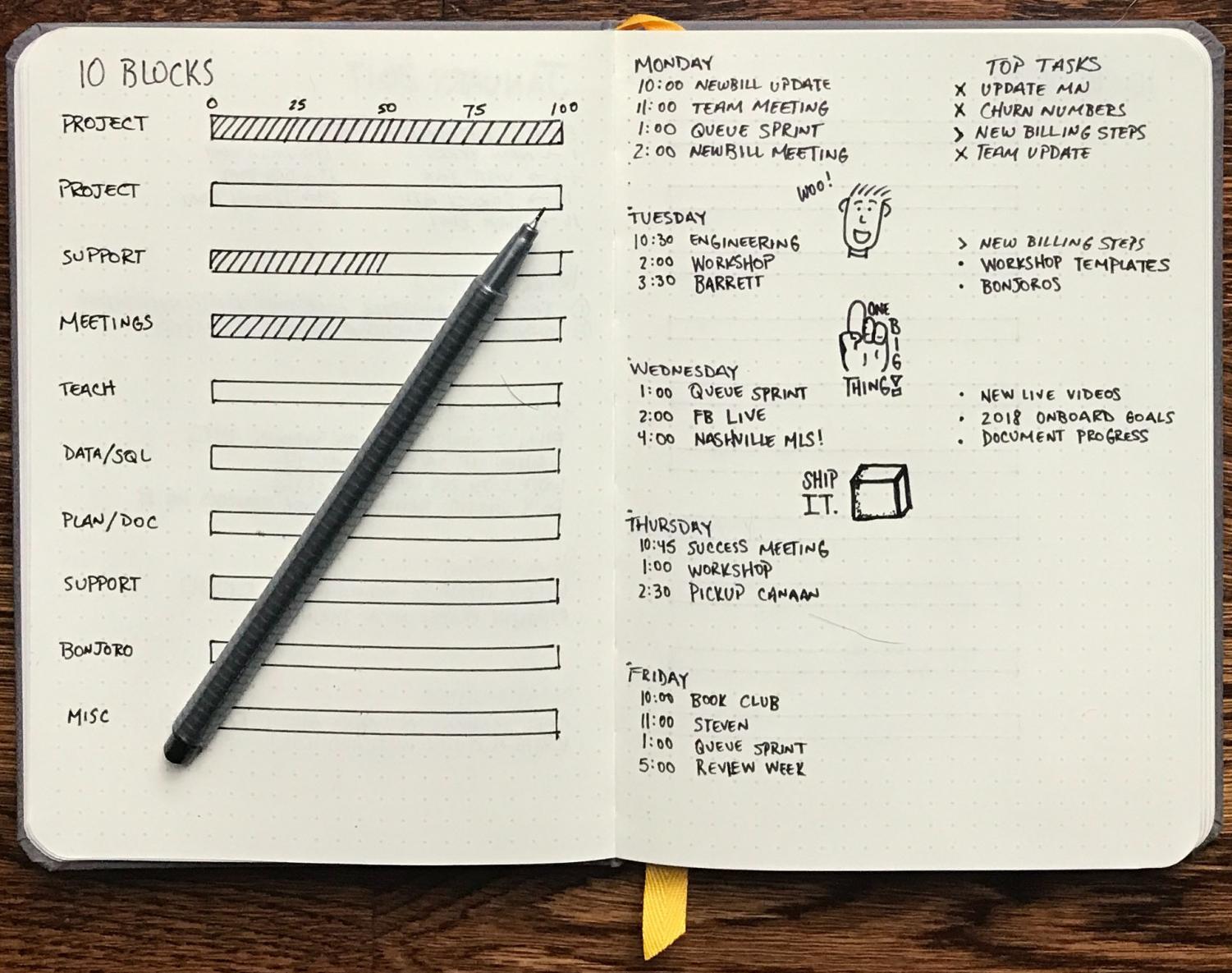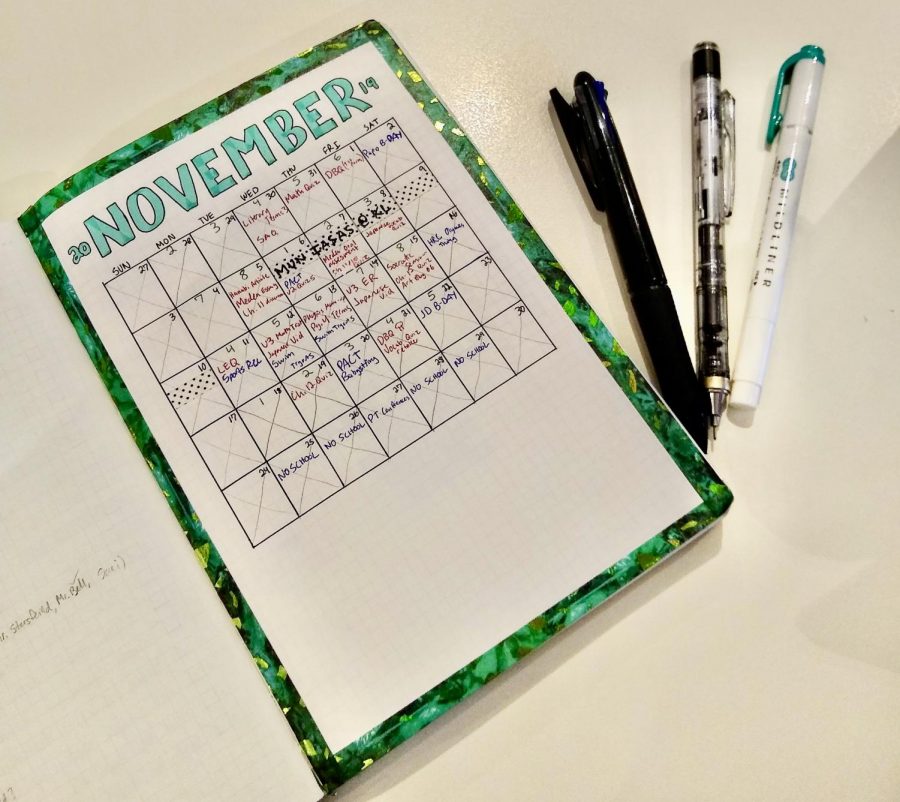Bullet Journaling: Staying Organized, Artfully
Photo by Maia Macek
December 17, 2019
It’s that time of year when many of us are feeling the pressure of being a high school student at ASIJ. When a few days left until winter break we can sometimes slip out of some of the good habits that we started the year out with… or at least I can. Something that has really helped me and other students to stay focused is bullet journaling. Bullet journaling is, according to bulletjournal.com, “a mindfulness practice disguised as a productivity system.” In other words, it’s a way to keep track of your life in an organized and often artful way.
The official bullet journaling concept was first created by Ryder Carroll, a digital product designer from New York who also was diagnosed with learning disabilities at an early age. Now, he has authored a New-YorkTimes bestselling book on the subject entitled The Bullet Journal Method: Track the Past, Order the Present, Design the Future.
Carroll also has a TEDx Talk about acting intentionally, which is what bullet journaling is all about. Since its creation, bullet journaling has taken social media by storm with tutorials on blogs, Pinterest and YouTube. There are even people making money by selling their bullet journal templates and printouts. A simple search for “bullet journal” on Pinterest or Instagram will produce thousands of results and variations on bullet journals. All this can seem a bit daunting, especially if you don’t have a lot of time.
Your bullet journal doesn’t have to be artsy or fancy or suck up lots of your time; it can just be a simple way to track your assignments and homework. In fact, spending time writing and or drawing out your weekly, monthly, or annual plans have been proven to be beneficial. An article from CNN Health describes and synthesizes several studies that show how creative activities and crafts can have effects similar to meditation and can be a natural antidepressant. When you do something creative and fun, your brain releases dopamine which can reduce stress. Additionally, creative activities like bullet journaling stimulate and activate different parts of the brain, which can help prevent dementia.
Last year, three now-seniors — Ashley Cornwell, Emily Udagawa, and Momo Hassan — presented their ideas about bullet journaling at theL2learning conference and presented at the student inspire assembly. They also plan to speak about their experience with bullet journaling in the middle school. Ashley reported that “It’s helped me plan my social life and extracurriculars around school.” Emily commented, “It basically helped me get everything I need to get done and overall be a lot more organized.”

Ashely explained, “My favorite thing about bullet journaling is how open it is. You can do anything you want. Sometimes if I really need to vent out my feelings I’ll write in it like a journal that you couldn’t really do in a planner.” Bullet journaling is a way to truly personalize organization, as all three girls mentioned when explaining the difference between a planner and a bullet journal.
These girls also discussed the benefits of bullet journaling outside of organizing their lives. “I like how it releases my stress because it’s kind of therapeutic to make calendars and to write everything down and plan it out. It’s a good way to de-stress while doing something that’s beneficial to you as well,” Emily affirmed.
Momo explained that the practice is a way for her to exercise her art skills and creativity while being productive and not feeling guilty about wasting time. Ashley also noted that bullet journals can have journal entries as well where she is able to get some feelings out on paper. Momo elaborated on how she got into bullet journaling: she was going through some tough times in her life but “When I started bullet journaling it allowed me to express myself [with] more creativity and positive energy. I feel like it definitely changed a lot about the way I not only view myself but think, really. I can write down anything that’s been bothering me. It’s been a positive out.” But, as Momo says, “It’s so hard to start.”
As for getting started, Ashley advised, “I think the big thing is recognizing how you are organizing yourself and if it’s not working for you I think it’s something to definitely consider trying.” Once you’ve done that, “All you need is a pen and paper and a ruler to draw out different planner sections. You don’t even need to buy an expensive journal to do it, you can just use pen and paper to plan out what you have to do. A lot of people watch videos of other people and then kind of copy that.”
Indeed, there are also multiple blogs and websites and videos that walk viewers through how to get started. Ultimately, it’s about motivating oneself to get started and being patient. Even these three experts had to start somewhere. Ashley revealed that her bullet journal “looks a lot nicer now that it did when [she] first started, for sure.” She recommends starting out with a pencil.
Many high school students are feeling the pressure of exams, assessments, and difficult classes. As Emily advised, “If your own method isn’t as good as it should be maybe trying something new out might help you.” Organizing yourself with a bullet journal is one way you can reduce some of the stress of high school.




















